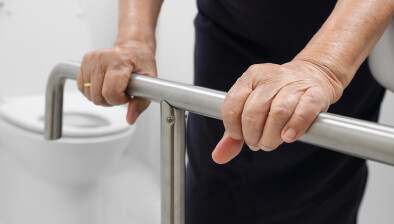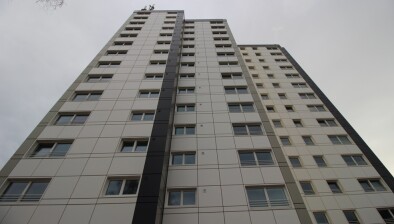Black’s Blog: Should we let our tenements crumble?

Jimmy Black hears that English flat owners who don’t maintain their blocks can lose their property without compensation. Should Scottish tenement owners face similar penalties?
Try taking a walk round Dundee’s cultural quarter and you’ll come to an abrupt halt at the foot of the old Hawkhill. The road and footway is blocked by scaffolding holding up a bulging tenement. Residents have been evacuated and the Tinsmith pub closed until further notice.
This used to be a slum area, known affectionately as The Blue Mountains. The story goes that an Italian painted blue mountains on his wall to remind him of home. Most of the Blue Mountains were demolished, but this tenement survived … until now.
In April this year, Glasgow woman Wendy Murray was forced to leave her flat by the city council when they discovered her tenement was held up by pillars which were weakened by severe corrosion. Back in 2006, the wall fell off a tenement in Glasgow’s upmarket Clarence Drive. And in July, a corner block on Kenmure Street, Glasgow, just fell down in the middle of the night.
Tenements are collapsing, and this is serious. Buildings which were saved from demolition in the 70s and 80s via Housing Action Areas and major investment from government are now needing more of that tender love and care to give them another thirty or forty years of life.
Should we let them fall down? All 895,000 of them?
It’s not just crumbling sandstone blocks in the big cities. Or granite buildings either. Professor Douglas Robertson tells the latest episode of the Scottish Housing News Podcast that there are big issues with tenements built in the mid-20th century.
RAAC is one issue causing problems in homes built by local authorities in the mid-1950s to the 1990s, but it’s not the biggest issue. There is a huge amount of money to be spent on eradicating dampness, fixing roofs, insulating walls, replacing gas.
So what’s the problem? Tenements tend to have multiple owners. Private landlords own a lot of them, and private landlords are often just one person. So you could have eight different owners in a tenement, with eight different attitudes to spending money on repairs and improvements.
They will have eight different Deeds, which should, in theory, make it clear how the management of the tenement should be conducted. But in practice, they may all say different things, or say nothing at all.
There is the Law of the Tenement, which provides a theoretical management scheme, but it only works if you can contact all the other owners and if the owners cooperate.
Audrey Murphy of Cumbernauld’s Abronhill Housing Association has 105 tenants in 70 closes. Abronhill is outnumbered by other owners in all but two of those tenements. 40% of those other owners are private landlords, and of those 140 own just one flat.
Recently contacting owners to get them to pay for emergency repairs to a common area was a major task; there was water running down the stairs and the ceiling above the stairs was in danger of collapse. They got the work done, but one owner never paid.
Douglas Robertson is not convinced that current proposals by the Scottish Government for every tenement to have an Owner’s Association, and five-yearly survey and a repairs fund will be enough to stop the rot. He points to other countries where shared domestic property is covered by strict laws. In fact, he mentions leaseholding in England. If you don’t pay the leasing fees, the freeholder can put you out of your home without compensation.
In a celebrated case in Dundee, the council bought owners, including private landlords, out of their tenements when their stair towers were condemned. In Aberdeen, the Scottish Government has thrown in millions to help the council cope with RAAC … how much will reach owner occupiers is as yet unknown.
But can we really afford to bail out people who have bought their flats, advised by surveyors and solicitors and who have then failed to maintain their properties?
Back in the 70s and 80s, we did well to invest in saving and refurbishing tenements. But we failed to do the really important part, which was to ensure a proper legal framework by which those tenements could be maintained. If public money is to be spent again, let’s not make the same mistake.
Jimmy Black and Kieran Findlay interviewed Audrey Murphy of Abronhill Housing Association and Professor Douglas Robertson for the Scottish Housing News podcast. You can find it here, along with references to publications on tenements and disrepair.
Jimmy Black is a City Councillor in Dundee and, until recently, chaired an RSL. He writes in a personal capacity.
The Scottish Housing News Podcast is co-hosted by Kieran Findlay and Jimmy Black. All episodes are available here as well as on the following platforms:









